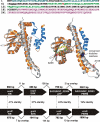In vitro studies indicate a high resistance potential for the lantibiotic nisin in Staphylococcus aureus and define a genetic basis for nisin resistance
- PMID: 21300840
- PMCID: PMC3088262
- DOI: 10.1128/AAC.01077-10
In vitro studies indicate a high resistance potential for the lantibiotic nisin in Staphylococcus aureus and define a genetic basis for nisin resistance
Abstract
Lantibiotics such as nisin (NIS) are peptide antibiotics that may have a role in the chemotherapy of bacterial infections. A perceived benefit of lantibiotics for clinical use is their low propensity to select resistance, although detailed resistance studies with relevant bacterial pathogens are lacking. Here we examined the development of resistance to NIS in Staphylococcus aureus, establishing that mutants, including small-colony variants, exhibiting substantial (4- to 32-fold) reductions in NIS susceptibility could be selected readily. Comparative genome sequencing of a single NISr mutant exhibiting a 32-fold increase in NIS MIC revealed the presence of only two mutations, leading to the substitutions V229G in the purine operon repressor, PurR, and A208E in an uncharacterized protein encoded by SAOUHSC_02955. Independently selected NISr mutants also harbored mutations in the genes encoding these products. Reintroduction of these mutations into the S. aureus chromosome alone and in combination revealed that SAOUHSC_02955(A208E) made the primary contribution to the resistance phenotype, conferring up to a 16-fold decrease in NIS susceptibility. Bioinformatic analyses suggested that this gene encodes a sensor histidine kinase, leading us to designate it "nisin susceptibility-associated sensor (nsaS)." Doubling-time determinations and mixed-culture competition assays between NISr and NISs strains indicated that NIS resistance had little impact on bacterial fitness, and resistance was stable in the absence of selection. The apparent ease with which S. aureus can develop and maintain NIS resistance in vitro suggests that resistance to NIS and other lantibiotics with similar modes of action would arise in the clinic if these agents are employed as chemotherapeutic drugs.
Figures

References
-
- Asaduzzaman S. M., Sonomoto K. 2009. Lantibiotics: diverse activities and unique modes of action. J. Biosci. Bioeng. 107:475–487 - PubMed
-
- Baba T., et al. 2002. Genome and virulence determinants of high virulence community-acquired MRSA. Lancet 359:1819–1827 - PubMed
-
- Bae T., Schneewind O. 2006. Allelic replacement in Staphylococcus aureus with inducible counter-selection. Plasmid 55:58–63 - PubMed
-
- Bates D. M., et al. 2003. Staphylococcus aureus menD and hemB mutants are as infective as the parent strains, but the menadione biosynthetic mutant persists within the kidney. J. Infect. Dis. 187:1654–1661 - PubMed
-
- Breukink E., et al. 1999. Use of the cell wall precursor lipid II by a pore-forming peptide antibiotic. Science 286:2361–2364 - PubMed
Publication types
MeSH terms
Substances
LinkOut - more resources
Full Text Sources
Medical
Molecular Biology Databases

